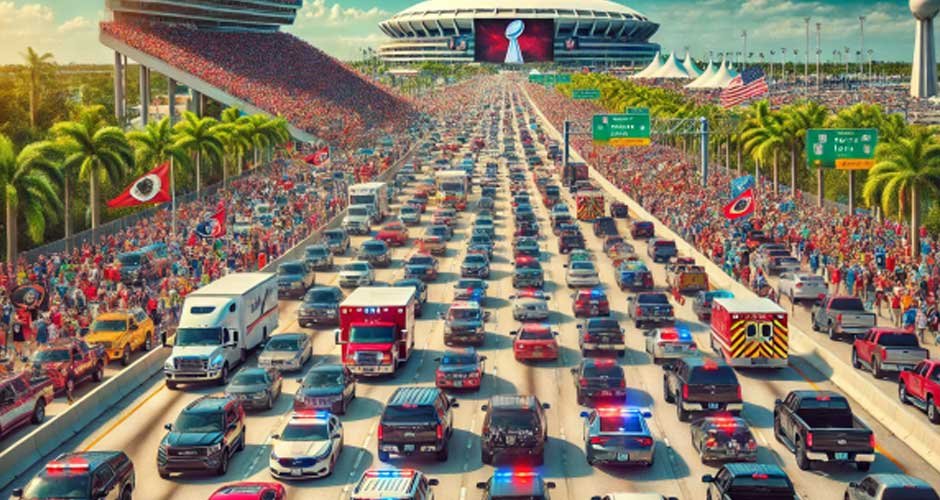Florida’s sports events are known for their vibrant atmosphere and significant impact on local communities. These events not only boost the state’s economy through tourism and the sports industry but also influence traffic patterns and accident rates. Studies have shown that car crashes tend to increase following professional sports events, particularly those involving large gatherings. This effect is seen across major leagues such as the NFL and NBA, as substantial crowds can lead to elevated traffic congestion and heightened risk on the roads.
The relationship between sports events and traffic incidents can affect various stakeholders, from local authorities to the Florida Sports Foundation. The foundation and similar bodies play a crucial role in promoting safety and minimizing disruptions caused by increased vehicle movement associated with major sporting events. In this context, tourism economics and amateur sporting events are areas of interest, as strategies often need adjustments to ensure fan safety and smooth traffic flow.
Efforts are underway to address these challenges through policies and infrastructure improvements. Influential figures in the Florida sports industry and government, like Governor Ron DeSantis, are actively engaged in refining the governor’s strategy to strike a balance between supporting the thriving sports economy and maintaining road safety. These initiatives are essential for ensuring that Florida remains a premier destination for sports tourism while keeping accident case rates in check.
Contents
Economic and Social Benefits of Florida’s Sports Events
Sports events in Florida contribute significantly to both the economic and social landscape of the state. They generate substantial revenue, create numerous jobs, and advance community well-being through physical fitness and improved infrastructure.
Financial Impact on the State Economy
Florida’s sports industry provides a significant boost to the state economy. A noteworthy study revealed that the industry had an impact of $146.5 billion in recent fiscal years. This economic activity helps support approximately 580,000 full-time jobs, contributing to the financial well-being of many residents. State and local taxes also benefit, with revenues collected from sports-related activities helping fund other vital public services. In essence, the sports sector is more than just entertainment; it’s a robust economic driver.
Boosting Tourism Through Major Sporting Events
Major sporting events are key to boosting tourism in Florida. Professional sports, along with significant events such as the Sunshine State Games, attract a large number of non-resident visitors. Tourists contribute significantly to local economies by spending on accommodations, restaurants, and local attractions. For instance, the Florida Grapefruit League and similar events draw crowds that support businesses throughout their duration. These events enhance Florida’s image as a top-tier sports tourism destination, further supporting the state’s broad economic landscape.
Advancing Community Health and Physical Fitness
Sports events in Florida play a crucial role in promoting community health and physical fitness. Recreational sports, such as fishing and hunting, offer leisure activities that encourage an active lifestyle. Programs like the Florida Senior Games provide opportunities for older adults to engage in various physical activities, enhancing both mental and physical well-being. The emphasis on physical fitness helps mitigate healthcare costs by encouraging a healthier population, ultimately benefiting the state’s social fabric.
Developing Sports Infrastructure and Recreational Venues
The development of sports infrastructure and recreational venues is an important aspect of the state’s growth. Investments in new facilities help host large-scale events and provide lasting benefits to local communities. Updated venues attract more significant events, further driving economic impact and job creation. These investments also provide residents with improved facilities for their recreational use, fostering community engagement and enhancing quality of life. By developing top-tier sports infrastructure, Florida solidifies its position as a leader in sports events.
Impact of Sports Events on Traffic and Road Safety
Sports events in Florida have a significant influence on traffic patterns and road safety concerns. These events can lead to increased traffic congestion, higher rates of motor vehicle collisions, and require strategic planning by authorities to enhance road user safety.
Assessing Traffic Congestion Due to Sporting Events
Sporting events can significantly increase traffic congestion, especially in urban areas. The influx of vehicles, particularly near event venues, often results in longer travel times and higher vehicle miles traveled. This congestion can extend beyond the immediate vicinity and affect roadways leading to major highways. Authorities often implement temporary traffic control measures to manage the flow, but the effectiveness can vary depending on the scale of the event and the existing infrastructure.
Vehicle and pedestrian volumes increase around popular events, highlighting the need for advanced planning. Smart traffic management systems and real-time monitoring are used in some areas to alleviate congestion. Public transportation promotion and park-and-ride initiatives are also encouraged to reduce the total number of vehicles on the road.
Evaluation of Sports-Related Accidents and Safety Measures
Motor vehicle collisions can rise during sports events due to distracted driving and impaired driving, often linked to celebratory activities around the venue. Research from the University of Florida highlights the correlation between sports events and increased accident rates.
Efforts to decrease pedestrian fatalities and boost road user safety involve strategic safety campaigns. The National Highway Traffic Safety Administration (NHTSA) collaborates with local agencies to enforce stricter driving laws around these timeframes. Increased police presence and roadside checks help deter violations, contributing to safer roads during these high-traffic periods.
Initiatives to Mitigate Accident Rates by Authorities
Various initiatives by local authorities aim to mitigate the impact of sports events on traffic safety. These include enhanced law enforcement measures and strategic deployment of emergency response teams. Some cities employ traffic safety education programs to raise awareness about the risks of distracted driving and the importance of vehicle safety checks.
Temporary road signs and dynamic message boards inform drivers of potential delays and safer routes. Collaboration with event organizers can result in improved pedestrian safety measures and designated drop-off zones to manage traffic efficiently. By focusing on preventative measures, authorities strive to minimize injury and ensure a safer environment for all road users.








